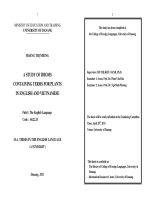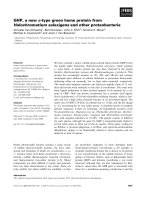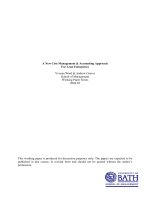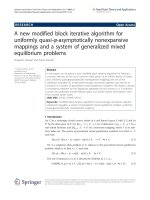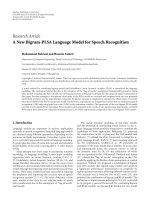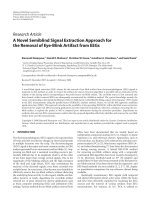A new integrated fuzzy QFD approach for market segments evaluation and selection.
Bạn đang xem bản rút gọn của tài liệu. Xem và tải ngay bản đầy đủ của tài liệu tại đây (233.93 KB, 3 trang )
Applied Mathematical Modelling 39 (2015) 3653–3665
Contents lists available at ScienceDirect
Applied Mathematical Modelling
journal homepage: www.elsevier.com/locate/apm
A new integrated fuzzy QFD approach for market segments
evaluation and selection
Luu Quoc Dat a,⇑, Thinh Thi Phuong b, Hsing-Pei Kao b, Shuo-Yan Chou c, Pham Van Nghia d
a
University of Economics and Business, Vietnam National University, 144 Xuan Thuy Rd., Hanoi, Viet Nam
Department of Industrial Management, National Central University, 300, Jhongda Road, Jhongli, Taoyuan 32001, Taiwan
c
Department of Industrial Management, National Taiwan University of Science and Technology, 43, Section 4, Keelung Road, Taipei 10607, Taiwan
d
Thuan Yen JSC, 62 Kim Dong Rd., Hanoi, Viet Nam
b
a r t i c l e
i n f o
Article history:
Received 4 April 2013
Received in revised form 24 October 2014
Accepted 20 November 2014
Available online 12 December 2014
Keywords:
Market segment selection
Fuzzy QFD
Fuzzy TOPSIS
a b s t r a c t
Market segment selection and evaluation are critical marketing activities of all companies.
To evaluate and select appropriate market segments, several decision makers and criteria
must be involved in the decision process. This study proposes a new integrated fuzzy
quality function deployment (QFD) to support the market segment selection and evaluation process. The proposed approach identifies the features that the market segments
should have (‘‘WHATs’’), in order to fit with the company’s business strengths (‘‘HOWs’’).
In the proposed approach, the relative importance of the ‘‘WHATs’’, the ‘‘HOWs’’–‘‘WHATs’’
correlation scores, the resulting weights of the ‘‘HOWs’’, and the impact of each potential
market segment, are assessed in linguistic values. The functions of the averaged ratings and
averaged weights are then defined, and fuzzy TOPSIS is used to obtain the final ranking of
alternatives. The computational procedure of the proposed approach is further illustrated
through a case study. Finally, this paper compares the proposed approach with another
fuzzy QFD approach, demonstrating the advantages of the proposed approach.
Ó 2014 Elsevier Inc. All rights reserved.
1. Introduction
Market segment selection and evaluation play important roles in increasing company competitiveness. In evaluating different market segments, many potential criteria and decision makers must be considered during the selection procedure,
and the outcomes of any choice are uncertain. Consequently, segment selection can be viewed as a highly complex and
messy problem [1]. Wind [2] referred to the selection process as a complex ‘‘art’’ to be performed by management, which
should take into account factors such as reachability, competitive activity, and ability to implement. Wind and Thomas
[3] determined the segment attractiveness using Kotler’s [4] criteria, including measurability, substantiality, accessibility,
and actionability. These criteria are translated into numerous other criteria, such as segment size, segment growth, segment
structural attractiveness, expected segment profitability, and risk. Nevertheless, existing literature offers only sparse
guidelines on how to evaluate and select segments, or focus on the design of segmentation studies and different approaches
for grouping customers [5].
Numerous studies in the literature have investigated segment evaluation and selection [5–14]. Freytag and Clarke [5]
presented a set of factors for the evaluation of segments, such as the expected demands on the company, the potential profit
⇑ Corresponding author at: No. 144, Xuan Thuy, Cau Giay, Hanoi, Viet Nam. Tel.: +84 (4) 37547506x309; fax: +84 (4) 37546765.
E-mail address: (L.Q. Dat).
/>0307-904X/Ó 2014 Elsevier Inc. All rights reserved.
3654
L.Q. Dat et al. / Applied Mathematical Modelling 39 (2015) 3653–3665
compared with the related risk, the competition, the ability to reach buyers in the market, technology, ability to gain a competitive advantage, and governmental and public moves. Market segments evaluation and selection may therefore be viewed
as a multiple criteria decision making (MCDM) problem. Most market segment selection and evaluation criteria are generally
evaluated by human judgment, and the evaluation is consequently subjective [11].
Tsai et al. [6] developed a novel market segmentation methodology based on product specific variables such as purchased
items and associated monetary expenses from customer transactional history, to resolve these problems. Lee et al. [7] proposed a practical evaluation tool for destination marketers to evaluate travel market segments in terms of the expected economic return on each identified segment. Chiu et al. [8] proposed a market segmentation system based on the structure of
decision support systems, integrating conventional statistical analysis method and intelligent clustering methods such as
artificial neural networks, and a particle swarm optimization method. Ou et al. [9] applied a five forces analysis to evaluate
and select market segments for international business using a strategy-aligned fuzzy approach. Xia et al. [10] presented an
innovative method for tourist market segmentation based on dominant movement patterns of tourists. Aghdaie et al. [11]
proposed a hybrid fuzzy MCDM approach for the evaluation and selection of market segments. Hanafizadeh and Mirzazadeh
[12] presented an approach which integrates a fuzzy Delphi method, self-organizing maps, and a visualization technique, to
cluster customers according to their various characteristic variables, and visualize segments by producing colorful market
maps. Nkurunziza et al. [13] adopted the stages of change model to identify potential cycling market segments, and to analyze and profile each of the market segments based on socio-economic factors, current travel behavior, attitudes, perceptions
and motivations. Chan et al. [14] proposed an integration of a fuzzy compression technique for multi-dimension reduction,
and a fuzzy clustering technique to perform market segmentation based on consumer requirements.
In recent years, fuzzy QFD has become a widely used quality tool developed to satisfy customer need in product design
and development. Fuzzy QFD provides a mean of translating customer requirements into appropriate technical requirement
for each stage of product development and production. In line with the multidimensional characteristics of market segments,
fuzzy QFD provides an effective framework for market segment comparison involving the evaluation of multiple criteria.
Research on fuzzy QFD has received a certain amount of attention. Some recent applications can be found in [15–24]. However, the procedure of most existing QFD approaches is not clearly developed.
In order to defuzzify the fuzzy numbers into crisp values, Facchinetti et al. [25] proposed an approach similar to Yager’s
[26] method for ranking fuzzy numbers. Several papers in the literature [15,17,27–29] involve fuzzy QFD theory and applications using Facchinetti et al.’s [25] and Yager’s [26] ranking approach. However, Ramli and Mohamad [30] indicated that
the ranking approach proposed by Yager [26] had some shortcomings. In addition, Chen et al. [31] mentioned that most
ranking methods are not suitable in fuzzy QFD, for the reason that when the relative weights of customer requirements
and the relationship measures between customer requirements and technical attributes are expressed as fuzzy numbers, calculating the importance of each technical attribute falls into the category of fuzzy weighted average, in which the derived
membership function of the fuzzy importance of each technical attribute is not explicitly known [31]. This paper therefore
applies a fuzzy technique for order performance by similarity to ideal solution (TOPSIS), [32] which has been a popular technique for solving MCDM problems to obtain the final ranking of alternatives. The fundamental idea of TOPSIS is that the chosen alternative should have the shortest distance from the positive-ideal solution, and the farthest distance from the
negative-ideal solution. Some recent applications can be found in [33–38].
As a result, this study proposes a novel integrated fuzzy QFD for supporting the market segment selection and evaluation
process. In the proposed approach, the relative importance of the ‘‘WHATs’’, the ‘‘HOWs’’–‘‘WHATs’’ correlation scores, the
resulting weights of the ‘‘HOWs’’, and the impact of each potential market segment, are assessed in linguistic values. The
normalized averaged ratings are then determined. Next, fuzzy TOPSIS is used to obtain the final ranking of alternatives. A
case study is further used to illustrate the computational procedure of the proposed approach. Finally, this paper compares
the proposed approach with another fuzzy QFD approach, demonstrating the advantages of the proposed approach.
The remainder of this paper is organized as follows. Section 2 proposes a new integration of fuzzy QFD and fuzzy TOPSIS.
The applicability and advantages of the proposed approach is illustrated through a case study in Section 3. Section 4 compares the proposed method with another fuzzy QFD method. Finally, conclusions are drawn in Section 5.
2. Proposed integrated fuzzy QFD approach
The proposed approach is based on the translation of house of quality principles from the product development field, to
the needs of competitive strategic management for market segment selection. While the traditional house of quality correlates customer requirements ‘‘WHATs’’ with engineering characteristics of a new product under development ‘‘HOWs’’, in
our approach customer requirements in terms of market segment assessment ‘‘WHATs’’ are crossed over with the company’s
business strengths ‘‘HOWs’’. The procedure of the proposed approach is described in these steps:
Step
Step
Step
Step
Step
1:
2:
3:
4:
5:
Identifying the market segments assessment ‘‘WHATs’’.
Identifying the company’s business strengths ‘‘HOWs’’.
Determining the relative importance of the ‘‘WHATs’’.
Determining the ‘‘WHATs’’–‘‘HOWs’’ correlation scores.
Determining the weight of the ‘‘HOWs’’.
